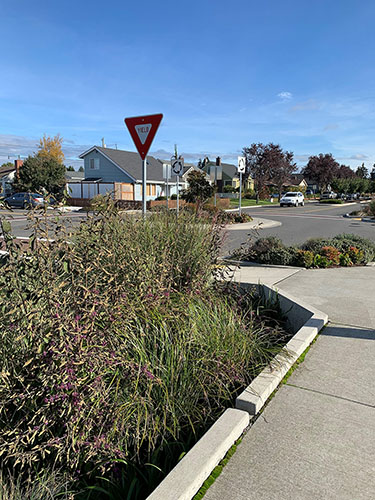|
Subscribe / Renew |
|
|
Contact Us |
|
| ► Subscribe to our Free Weekly Newsletter | |
| home | Welcome, sign in or click here to subscribe. | login |
Construction
| |
 |
March 28, 2024
Planning for a rainy day, every day
Department of Ecology

McGowan
|
When the rains come, we see water flowing down streets, across parking lots, and into those seasonal stormwater ponds scattered all around. We see water rising in streams and rivers. What we don’t always see is the pollution that gets swept up in that stormwater. Unmanaged, stormwater can erode streambanks, damage salmon habitat, and carry oils, metals, pesticides, bacteria, trash, and tire rubber particles straight into Washington’s rivers, lakes, and Puget Sound.
Washington communities are investing in managing stormwater in a way that supports our growing population and strong economy, while protecting the environment. Managing stormwater can look different in every neighborhood, town and city. Stormwater infrastructure can be hidden in plain sight. For example, low-impact development design principles leading to more green spaces people can enjoy when the sun is out, and when it rains, these green spaces filter chemicals and metals from stormwater.
Although the idea of low-impact development is pretty straight-forward, the planning and design needed to successfully meet this challenge can be extremely complex. Investing in effective stormwater management infrastructure is a long-term, large-scale commitment for the entire state.
This year, the Department of Ecology has a number of projects underway that will improve our stormwater infrastructure, fund local stormwater projects, and support new research to better understand emerging pollutants in stormwater. All of these efforts are possible due to ongoing collaboration and on-the-ground work by local governments.
UPDATING THE STORMWATER PERMITTING PROGRAM
Ecology’s water quality permits address the pollution that can come with stormwater. Municipal stormwater permits require public entities, such as cities, ounties, and the Washington State Department of Transportation, to regulate and manage stormwater from urban and suburban landscapes by developing comprehensive Stormwater Management Programs. The overarching goals are to let rain soak into the ground where it lands, prevent stormwater pollution at its source, treat stormwater to remove pollutants, and control the flow of stormwater runoff. All of these actions result in cleaner water going into creeks, rivers, lakes, groundwater, and Puget Sound.
In 2023, Ecology proposed updates to these municipal stormwater permits, including important updates to address specific pollutants and to ensure that, as communities change and grow, work is done to invest in proper stormwater management and protect water quality.
NEW DEVELOPMENT AND REDEVELOPMENT
Including stormwater best-management practices, such as runoff treatment and flow control, in the planning for new development and redevelopment projects is the most cost effective and efficient way for communities to manage stormwater. The permit updates Ecology proposed will result in more stormwater treatment, meaning less pollution in state waters.
INCENTIVIZING RETROFITS
Existing development built before modern stormwater management requirements were in place is the greatest threat to water quality and also provides an important opportunity to better protect local waters. Ecology proposed updates that will lead to more stormwater infrastructure retrofit projects, adding stormwater treatment facilities where they are needed most. A few of the ways we are doing this is by incentivizing multi-jurisdiction collaboration, increasing benefits to overburdened communities, and prioritizing retrofit projects in high pollution-generating areas.
We received a lot of helpful feedback on our proposal, both the early drafts and during the formal comment period. We plan to make our final decision on the updated permit requirements by July of this year.
SUPPORTING LOCAL STORMWATER INVESTMENTS
Municipal stormwater programs are funded through local stormwater utility fees. Washington is unique in the amount of state funding passed to local governments in the form of stormwater grants and loans. Cities, counties and ports use this funding to create staff positions; to design and build new stormwater facilities, such as bioretention facilities or engineered wetlands; and to treat and manage runoff across the state.
Every year there are opportunities for stormwater project funding. In January, we announced our annual draft list of funding for clean water projects. This year’s list includes $38 million for stormwater projects.
A TRIED-AND-TRUE APPROACH TO NEW CHALLENGES
With new research, evolving science, and lessons learned, we are always working to do more and do better to sustain healthy, thriving watersheds and provide cool, clean water to fish, shellfish, wildlife, people and businesses.
Investments made in researching new pollutants can lead to game-changing discoveries, such as the discovery of 6PPD-quinone in 2020. 6PPD is a chemical used in vehicle tires and its by-product, 6PPD-quinone, can kill salmon and cause toxic effects in other aquatic life. If stormwater isn’t managed appropriately, 6PPD-quinone ends up in salmon-bearing waters. A great deal of work is being done to address 6PPD, including finding safer alternatives.
The good news is that many of the existing stormwater best management practices like bioretention are proving effective at capturing 6PPD-quinone and reducing the amount that goes into the water. This means the investments communities made in recent years to install stormwater treatment are already helping to address this toxic chemical.
Even so, the Department of Ecology is updating stormwater permits and related stormwater management manuals to address this threat. We are conducting and funding research to better understand 6PPD-quinone and the best management practices that can keep this and many other toxic pollutants out of local waterways. From studying the effectiveness of street sweeping and different types of stormwater treatment, to conducting sampling to determine the persistence of 6PPD-quinone in different waterbodies, universities, private businesses, municipalities, Tribes, and state agencies are collaborating on projects that will inform stormwater management decisions and help communities make meaningful investments.
In the coming months, we’ll announce new funding opportunities through Requests for Proposals and Interagency Agreements to conduct 6PPD stormwater best management practice effectiveness research and pilot projects. Combined, Ecology and the National Estuary Program will have more than $3 million available in funding for this work.
This funding represents yet another opportunity for us to work together to better protect our waters for decades to come. As climate change makes weather patterns less predictable and more extreme, and new research helps us prioritize treatments that will best manage a wide range of toxic pollutants, the need for us to collectively continue to invest in stormwater management only stands to grow.
Vincent McGowan is the program manager for the Department of Ecology’s Water Quality Program.
Other Stories:
- Centering equity, reconciliation and community in coastal adaptation
- Eastside cities partner for climate action
- Reclaiming our shores
- Five environmental factors influencing construction in 2024
- Buried treasure: harnessing waste heat for a cleaner future
- Floating wetlands strengthen urban ecosystems and community engagement
- A park for all people — and the environment



